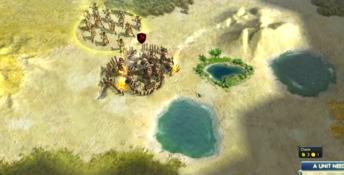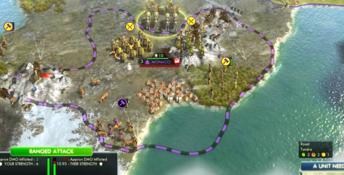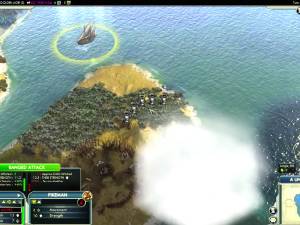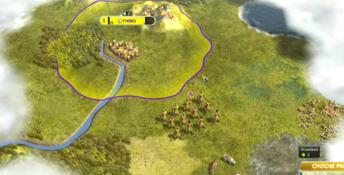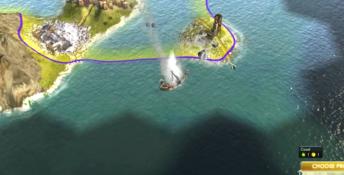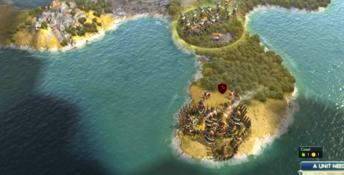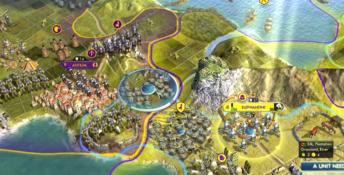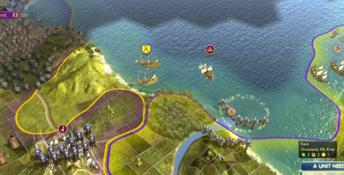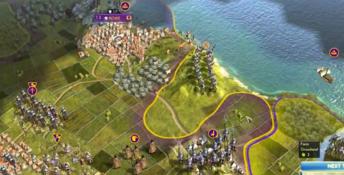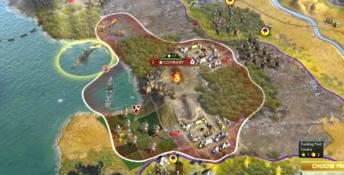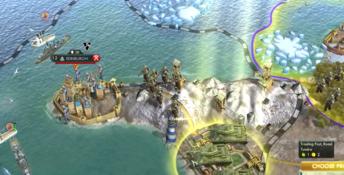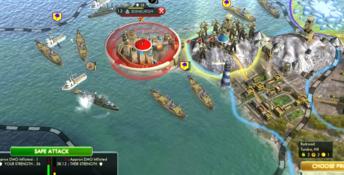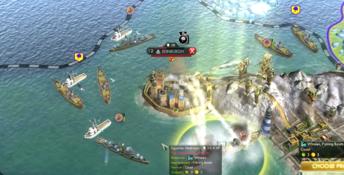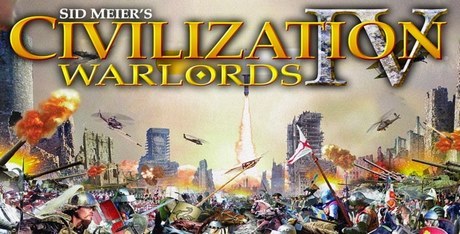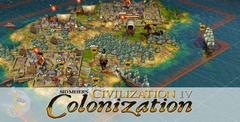Sid Meier's Civilization V
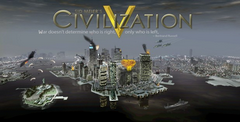
| a game by | Firaxis Games |
| Platform: | PC (2010) |
| User Rating: | 9.5/10 - 4 votes |
| Rate this game: | |
| See also: | Turn Based RPG, Mouse Only Games, Civilization Games, 4x Games |
Sid Meier's Got a lot to answer for, whole generations falling under the thrall of his ludicrously addictive culture-'em-up.
You can kind of tell just how much people love the Civilization games just by looking at the reaction to the news it was ditching square tiles for hexagons. You don't get many people talking about hexes these days, but when Sid adopts them, they suddenly get all kinds of attention. Hexagons, seriously.
Really though, their implementation has been seamless, if the build we've been playing is anything to go by. They've given the game a more interesting strategic feel, with more realistic boundaries to your empire and a more sophisticated movement system. Most importantly, shorelines are less jagged. It affects combat too, which is perhaps what's been changed the most since Civilization IV.
No Pile-Ups
First of all, gone are the super-stacks. Only one combat unit can occupy a hex at any one time (with Settlers slinking inside as well, if needed) so you'll be fighting with less units than you'll have been used to. Like any hex-based strategy, positioning your units effectively is the key, to the point where battle lines and flanking manoeuvres come into play.
This is unheard of for a Civ game, where the combat has been one of the least fun elements. Now, someone who used to eschew fighting might find themselves using it as an option more often than ever before, simply because it doesn't involve just building up a ludicrous stack of tanks and then steamrollering your way through the enemy. The positioning of cities has always been important, but now it is vital. If you can get a front-line city into an area where you can bottleneck the enemy, he can only deploy one or two units at a time, severely limiting his effectiveness.
Two other big things affect combat the first being ranged attacks. No longer are archers only used for defence, as their new ability to shoot enemies from a distance makes them lethal when screened by spearmen.
The other big thing is that, with the right tech advance, any land unit can transform into a set of boats and move over stretches of shallow water, meaning no more stupid ferrying about of tiny numbers of units. Overseas invasions are now much easier to set up, although when in their 'embarked' form, the land units are incredibly easy to kill, so you'll still need to protect them with a navy.
This is just scraping the surface of the new combat system, and there's still so much more to cover. Civ is a game of so many separate elements, it's impossible to properly analyse them in two pages, instead I'll focus on some of the things that jumped out at me. City States are a new addition, these are small regional factions that you can ally with, or crush. Do the former and they'll provide assistance in battles, plus constantly give you gifts and bonuses, depending on their status. Genoa once gave me a catapult,-for instance.
Endless Nameless
Bigger empires are now represented by fully animated characters, rather than the talking heads of yesteryear, with more diplomatic options and, it seems, a more realistic approach to how things work in that sphere. There aren't so many civilisations to pick when starting a game, but each leader speaks in their native language, and there'll be more available in DLC packs. Neither is there a pimpable Palace to play about with, nor a 'Sid' level of difficulty. Civics have been replaced by culture-based social choices, a tree system where you spend culture points to unlock new abilities. There's so much more to Civilization V than the few little things we've talked about here. There's been no chance to talk about research pacts, the way barbarians work now, and all the other tiny yet brilliant touches CiVis known for. The core new ingredients all seem to work well, seamlessly integrated into a traditional Civ experience. It's Civilization, both as we don't and do know it, and it looks like it'll still be utterly, utterly brilliant fun.
Download Sid Meier's Civilization V

System requirements:
- PC compatible
- Operating systems: Windows 10/Windows 8/Windows 7/2000/Vista/WinXP
Game Reviews
Civilization was born of Sid Meier's love of history, and his ability to spend long isolated hours turning the elements of that love into a workable gaming prototype. Civ obviously isn't history - it's a game that retells history in the millions of ways it could have happened, if our world's most famous leaders had been immortal and played videogames.
Civ 5 has a number of radical changes going on, but it's a testament to that original prototype, how much of that original game is still intact. Some things are sacrosanct: you start with a bunch of Settlers, build cities, and spend millennia progressing along a tech tree, aiming for a victory based on military might or peaceful scientific or cultural evolution.
That's what Civilization is: a turn-based alternate history of mankind. But everything else about its gameplay is up for grabs, and by putting former modder and enthusiastic young blood Jon Schaffer in the lead development role, Firaxis have come up with something that feels genuinely fresh.
Civilization IV refined the game's formula to be a balanced and full experience, but it was hard to pinpoint exactly what made it so shockingly new. The fifth game-well, you can probably already see.
Sexy Sixy
Hexagons, eh? Phwoar. Look at those gorgeous honeycomb bastards. One of CiVs most stubborn and archaic features, the square grid, dies this year on the PC. Whether it continues to live on in the new, free-to-play Facebook incarnation, CivNet, has yet to be seen. Firaxis seemingly comfortable with the idea that the main franchise, the simpler console and handheld versions, and the free-to-i multiplay Facebook version, CivNet, can co-exist, each adding in their own E way to the Civ brand.
The benefits of six-sided geometry are immediate, in terms of aesthetics: narrow channels of water meander more convincingly through the terrain, and the two extra corners give coastlines a plump, kissable roundness. Civ has always felt like a kind of board game people would play, if they could be trusted not to lose all the pieces or draw a Hitler 'tache on the Gandhi counter, so when hexagons are unveiled, I quickly go from "Ooh!" to "Took your bloody time!"
There's another rule that makes the map a less bewildering place: military units cannot share a space. For anyone who's not a Civ fan, you're probably not impressed by that. But you haven't lived with stacks of military units as long as we il have. No more teetering stacks of hard-researched muscle, terrorising the map with its military might and precarious swaying. Now, tactical deployment is paramount to military success: a hex that has crap warriors in is a hex that can't have cavalry. There's some flexibility: jet planes can fly overhead, and special units such as Spies and Great People will be able to squeeze through the ranks on their way to wherever. You can also swap units over, meaning a long battle front is still flexible: if your cavalry meet up with some pikemen, you can fire on them from a distance with your archers, and tell your infantry to swap places with your horses. At this point, the room was full of palms being flexed, as people wanted to play it.
Civ 5% battle system is closer, Firaxis claim, to true tactical combat. Schaffer is a huge fan of 1994 classic Panzer General, and these are the ideas he's brought with him. Combat is being taken out of the borders of cities and onto the map, making Civ 5 much more of a spectator sport.
Cultureswell
Your civilisation also grows in a new way. No more concentric rings of influence, automatically earned as your culture is boosted by all those obelisks you've been building. Culture still plays the same role in boosting your terrain - and you can buy new areas too, as gold is being given a more central role - but your empire grows one hexagon at a time. Every hex you earn is personally chosen, and becomes a permanent part of your empire's production machine.
Empires grow at roughly the same rate, so it's a lot of manual baby-steps instead of an automatic one, but the way your empire grows is such an elemental part of your strategy, that this doesn't feel like unwelcome micromanagement.
This growth is when a nearby City State might become a problem. City States are new to Civ5 - they're like what'd happen if barbarians decided to do a town. Never aspiring to full civhood, their role is different - they can offer bonuses to those allied to them. Or, if they're in the way of your glorious and fruitful expansion, destroy them for a one-off bonus. Naturally enough, this will give you a reputation as a warmonger, and might disincline other, more important civilizations, from having peaceful dealings with you.
The individual personality of the leaders are now set using a variety of flavours. (I'll spell Civilization with a z, because it's the title of the bloody game -but I draw the line at "flavor".) The grid I'm staring at, while Ed Beach (who worked on the Hubble space telescope) talks to us about Queen Victoria, contains references to these flavours, grouped in different colours. Red has wide strategies such as offence, defence, and military training. Another colour groups military preferences into ranged, mobile, naval, and air. Recon and Naval recon bag a colour of their own, as do naval growth, expansion, and growth. It's interesting only for the terminally curious, so I won't bore you with the rest. (Actually, I will: another colour contains development preferences like culture, infrastructure, happiness, Great People and Wonders.)
But each leader has base scores in these numbers, spiced up with a random element, and changing through the game to adapt to the needs of the current situation. It's a system that makes you want to stop talking and play the damn game.
Mind, Civ's AI has never really been about powerfully outwitting you. The difficulty has traditionally come from cheats and enemy bonuses, but they're really trying to pinpoint what makes a good Civ player. Firaxis decided it's someone who can.think on many levels, so the new system has four levels of decision making. One eye is on the overall game strategy (would it make more sense to switch your win strategy to a culture win?), and one eye on the dirtier tasks of engagement. Then, two more eyes, one on economic and military development, and the other on moving units around, making sure not to miss terrain bonuses and suchlike.
Writing about Civ is hard because of the audience: a crowd of demanding enthusiasts who are primed to love or be outraged by everything you say, and a larger crowd whose indifference towers above that passion. Is my job to whip up the enthusiasts, or to convince the indifferent that they're missing out? Twenty years on, hasn't everyone already made their mind up about Civ?
Firaxis don't think so. 2008 was a two-pronged assault on the casual and hardcore market, with Civilization Revolution and Colonization taking on both teams. This year we've got Civilization 5 for the hungry, and CivNet for the unconvinced. Right now it looks like Civ 5 is the most accessible, good-looking, and reassuringly deep, of the hardcore side of the franchise yet.
Snapshots and Media
PC Screenshots
See Also
The update has small but welcome improvements to the interface.
